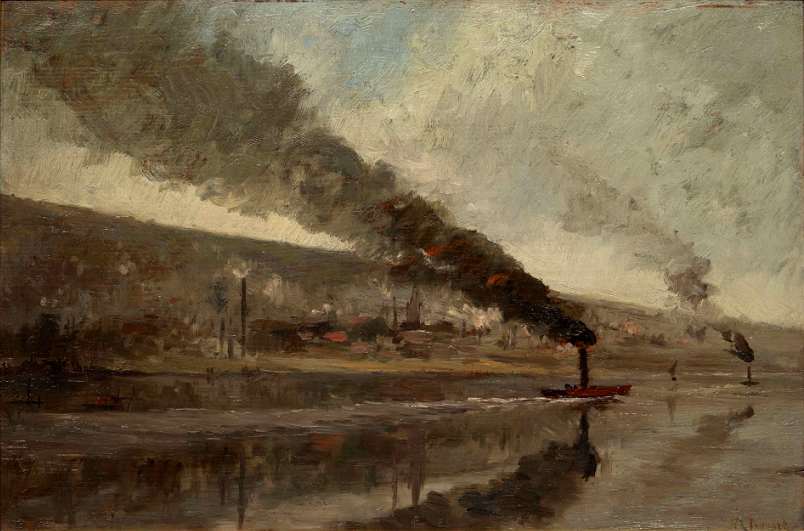Some of those showing their paintings at the First Impressionist Exhibition in April 1874 were amateurs. Among the more important of them was Stanislas-Henri Rouart (1833-1912), a close friend of Edgar Degas and Gustave Caillebotte, who became a patron of the Impressionists and helped fund their exhibitions.
According to the exhibition catalogue, Rouart exhibited a total of eleven works:
- Breton Farm,
- Bank of a Pond,
- View of Melun,
- Village,
- Forest,
- Breton Road,
- Breton Farm (watercolour),
- Béarnaise Houses (two watercolours),
- Two etchings.
Only the third of those appears to be accessible today.
Rouart came from an affluent background, his father owning a major manufacturer of military uniforms. He went to school with Edgar Degas, and then studied painting under Léon Cogniet and Édouard Brandon, who also exhibited at the First Impressionist Exhibition. Although Rouart remained a keen amateur artist, he was a successful entrepreneur, setting up a manufacturer of motors for industrial refrigeration plant and in steel manufacturing. He was also an avid collector, starting with paintings by Corot and Millet, who influenced his own art, then buying paintings from the French Impressionists to assemble one of the first major collections of their work.
At the time of the First Impressionist Exhibition, he gave his address as 34, rue de Lisbonne, Paris, an affluent area near the Arc de Triomphe and the Parc Monceau in the 8th arondissement, just a few doors away from Gustave Caillebotte, who lived at number 13.
Rouart’s paintings had already been exhibited at the Salon before the Franco-Prussian War in 1870, and again in 1872, but he had to show two of his paintings in the Salon des Refusés the following year.
(I apologise for the small size of most of the following images.)

His Terrace on the Bank of the Seine at Melun (1874) is one of the few paintings of his which has gone into a major museum, that of Musée d’Orsay in Paris, and is probably the View of Melun shown at the First Impressionist Exhibition. Melun is a small town to the south-east of Paris, up the River Seine, and to the north of the Forest of Fontainebleau.

Mountains of Flowers (c 1875) shows his particular love of flowers and gardens, and his gentle painterly style.

Garden (c 1875) appears to be a graphite and watercolour sketch on textured paper.

Hélène Reading, Rue de Lisbonne (date not known) is one of a series of portraits that he painted of his wife when they lived in Paris, and is looser in its facture than his earlier landscapes.

Walls of a Farm, Queue-en-Brie (c 1880) shows the farmyard of the family’s country property, to the south-east of Paris. I don’t know whether its unusual stippled appearance is true to the original, or an artefact of the image.

His Recumbent Nude (c 1880) is also rich in brushstrokes and very painterly.

The Seine near Rouen (1880) is unusual in his work for its depiction of industry.
In 1883, he ended his business involvement so that he could concentrate on painting and collecting. He continued to show his paintings, reaching a peak of twenty-six in the eighth and final Impressionist Exhibition of 1886.

In about 1885, Rouart visited Italy, where he painted Venice, San Michele, showing the church of San Michele in Isola, on the island with the city’s main cemetery.

Landscape with Bathers (date not known) explores a motif which may have been inspired by Manet.

In Fontainebleau Forest (date not known) may have been inspired by Corot, but is a realist study in light, shade, and the texture of bark.
Henri Rouart seems to have continued painting and collecting until his death in 1912. His legacy was substantial: in addition to one of the major collections of Impressionist art, one of his four sons, Ernest (1874-1942), continued the tradition as a painter and collector. Perhaps it’s appropriate that Ernest Rouart was born four months after the First Impressionist Exhibition, and married Julie Manet, daughter of Berthe Morisot and Édouard Manet’s brother Eugène.
References:
The First Impressionist Exhibition (in Italian), containing
the exhibition catalogue
Bona, D (2014) Les Rouarts. De l’Impressionisme au Réalisme Magique, Gallimard. ISBN 978 2 07014 386 3.

